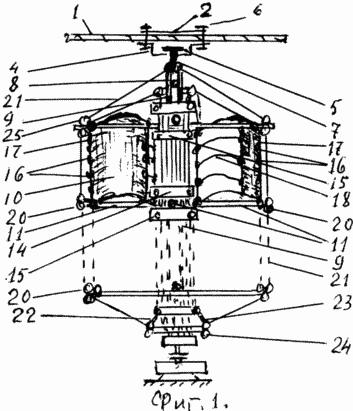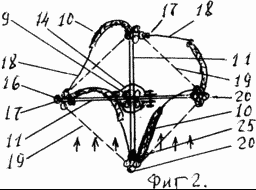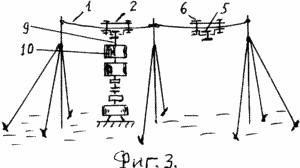| Start of section
Production, amateur Radio amateurs Aircraft model, rocket-model Useful, entertaining |
Stealth Master
Electronics Physics Technologies Inventions |
Secrets of the cosmos
Secrets of the Earth Secrets of the Ocean Tricks Map of section |
|
| Use of the site materials is allowed subject to the link (for websites - hyperlinks) | |||
Navigation: => |
Home / Patent catalog / Catalog section / Back / |
|
INVENTION
Patent of the Russian Federation RU2115018
![]()
WIND SAILS POWER PLANT "VEPG"
The name of the inventor: Georgy Vladimirovich Ginkulov
The name of the patent holder: Ginkulov Georgy Vladimirovich
Address for correspondence:
Date of commencement of the patent: 1995.07.21
VEHG can be mounted from one or several windmills. Each VEHG propulsion unit is assembled from separate parts (sails, rods, halyards) directly on a suspension consisting of four cables forming a flexible power shaft connected to the bearing. And this bearing is clamped with a clamp on a horizontal cable, which is stretched between two or three tall masts. The wind turbine itself is assembled by inserting between the four cables of a flexible shaft two sturdy rods perpendicular to each other and to a flexible shaft. These two rods, fixed by clamps on a flexible shaft, form one cross, and lower, to the height of the sail, the second cross is likewise mounted. And between the two crosses (on their shoulders) are hung four sails, since there are only four pairs of shoulders - four sails. But the sails are hung so that the moment of one of the four sails acts on the flexible shaft all the time, transferring this rotation to the generator installed below. This is due to the fact that the vertical edge of the sail, which is further removed from the center, is, as it were, a hinge, with which the whole sail can perform oscillatory movements, and the other vertical edge is attached to the leashes. The free ends of these leashes are attached to the vertical outer edge of the adjacent sail. The width of the sail and the length of its leashes must have a slack, but such that the efficiency of the working stroke is maximized. With this chosen slack of leashes, that sail, which is exposed by the wind, makes a working stroke, while the other three sails are "prepared" for this move. The technical result consists in increasing the efficiency of the wind farm, simplifying the design, reducing the operating costs for installation and construction.
DESCRIPTION OF THE INVENTION
The invention relates to the field of wind power, in particular to sailing wind turbines, which can be installed on ships and on land and can be used in areas where strong winds prevail and there is a shortage of electrical energy.
A wind power plant is known, which contains four sails in each wind turbine, which are working blades.
The purpose of the invention is to increase the efficiency of the wind farm, simplify the design, reduce the operating costs for installation and construction.
The goal is achieved by the fact that the propellers of the VESG are sails mounted on a flexible shaft that rotates on a suspension.
 |
 |
 |
In Fig. 1 shows only one four-propeller VEHG propulsor, side view; In Fig. 2 - a top view of this propulsor in its working moment; In Fig. 3 - external view of low-power VEHG.
To rotate the generator on the VEHG, wind propellers (VD) of sailing type are used. They can be several, united in one garland, which is fixed to the horizontal cable 1 by means of a clamp 2 consisting of an upper bar 3 and a lower U-shaped strip 4 in which a bearing 5 is fixed. The bars 3 and 4 are fixed to the cable 1 by four bolts 6 (there are only two of them in Fig. With bearing 5 are connected four power rings 7, in FIG. 1, only two rings 7 are visible. Two of them are stretched two cables 8, the length of which must be such that after they are extended into these rings, 8 they must be pulled out from the ends to a generator mounted on the ground. Hence, the resulting flexible shaft 9 consists of four cables, the generator shaft and is in an upright position. Four sails 10 are suspended between two crossings 11. Each spider 11 consists of two rods 12 and, in the middle of each rod 12, two short lengths of wire are perpendicular to each other, forming a small cross 13 that keeps the rod 12 from being displaced along its axis. And each crosspiece 13 is kept from displacement along the axis of the flexible shaft 9 by special two arcuate clamps 14, one clamp on top of the crosspiece 13, and the other from below. So, each propeller consists of two crosses 13 and four sails stretched between them. Depending on the power of the EPS on the flexible shaft, several propellers forming a garland of propellers can be mounted. The power of the EPS can be increased by the number of these garlands, and hence the number of generators. For VEHG, low-speed generators are used.
The work of the WEGP is implemented as follows
In Fig. Figures 1 and 2 show that at this point in time only the left sail communicates the rotation of the flexible shaft, and the remaining three sails do not give a spin, but they almost do not interfere with this rotation, since at this moment they turn in the wind. This is achieved due to the fact that all the outer vertical edges of all four sails are tied to the jumpers 17 by the nodes 16. These nodes 16 are like hinges for the "doors" - sails 10, and the filament wires 18 rotate these "doors" -sail 10 so that One of the sails worked in full force, and the other three consistently prepared for this work using the wind. From Fig. 1 and 2 that one ends of the leashes 18 are attached to the sails 10 and their other ends to the bridge 17 but on the other adjacent arm of the same cross 11. The length of the leashes 18 must be strictly defined, otherwise the working stroke of the sail will have Low efficiency. In HD of large dimensions, the ends of their crosses 11 must be joined by horizontal webbing stretches 19, tie them to the ends 20 that are at the ends of these crossings 11. FIG. 2 these stretches 19 are represented by dashed lines. The horizontal position of the arms of all the crosses 11 is regulated by four web stretches 21.
The constructive idea of stopping the rotation of the entire garland of propellers looks very simple. With the tension of the tows 22, all the bridges 17 are assembled to the center, pressing the sails against the flexible shaft 9, and by pulling the tows 23, all the jumpers 17 move from the center, revealing all the sails of the garland. The ends of the tows 22 and 23 are attached below to a small crosspiece 24 which is of the same construction as the crosspiece 11. Each tow 22 and 23 consists of several shoelaces. Each lace controls only one sail, since all of the upper ends of these laces are tied to the upper rings 25 of each sail and when the harness 22 or 23 is tensioned, these rings 25 will slide over the arms of the cross 11, folding or opening the sails.
CLAIM
The device of a wind powered sailing power plant containing four sails in each wind turbine, which are working blades, characterized in that the working blades are suspended between two crosses, the leashes are attached to one of the sails at one end, and the other end is fixed to a bridge on the other adjacent arm of the crosspiece, a flexible shaft, Transmitting the rotation from the wind turbine to the electric generator, assembled into a bundle of four cables, and the crossings on which the sails are suspended are made of two rods and fixed by the clamps on this shaft, the propellers are formed into a garland capable of rotating a slow-moving generator.
print version
Publication date 31.01.2007gg




Comments
Commenting on, remember that the content and tone of your message can hurt the feelings of real people, show respect and tolerance to your interlocutors even if you do not share their opinion, your behavior in the conditions of freedom of expression and anonymity provided by the Internet, changes Not only virtual, but also the real world. All comments are hidden from the index, spam is controlled.